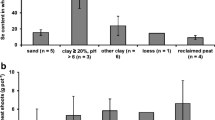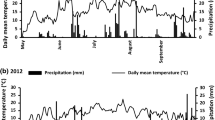Abstract
The objective of the present study was to investigate the influence of soil organic matter content and pH on plant availability of both inorganic and organic selenium (Se) fertilisers. Further, the risk of Se leaching after application of inorganic Se fertiliser was evaluated. A new interpretation of an older field study at different sites in Southern Norway showed that organic C was correlated with grain Se concentration in wheat, barley and oats, explaining up to 60% of the variation in Se concentration. Pot experiments with a peat soil, a loam soil and a peat/loam soil mixture were conducted for the present study at a range of pH values between pH 5 and 7. Below pH 6, Se uptake from added Se fertiliser was higher in the soil types with high organic matter content than in the loam. The opposite occurred at a soil pH above 6, where Se uptake was higher in the loam than in the peat soil. A simple leaching experiment after one growing season confirmed the findings of the pot experiments that Se availability in the loam soil with a relatively low organic matter content increased with increasing pH, whereas it decreased in the peat soil. Neither Se yeast, nor pure Se methionine, used as organic Se fertiliser, resulted in any significant uptake of Se when added at concentrations similar to the inorganic Se applications.


Similar content being viewed by others
References
Abrams MM, Shennan C, Zasoski RJ, Burau RG (1990) Selenomethionine uptake by wheat seedlings. Agron J 82:1127–1130
Bakken AK, Ruud L (2000) Mineralinnhald i gras gjødsla med selenhaldig Fullgjødsel—mineral content of grass fertilised with selenium-enriched NPK fertiliser. In: Grønn Forskning 05/2000, The Norwegian Crop Research Institute, pp 120–124
Bremner JM, Mulvaney CS (1982) Nitrogen-total. In: Page AL, Miller RH, Keeney DR (eds) Methods of soil analysis part 2. ASA, Madison, Wisconsin, USA, pp 595–624
Cary EE, Allaway WH (1969) The stability of different forms of selenium applied to low-selenium soils. Soil Sci Soc Am Proc 33:571–574
Egnér H, Riehm H, Domingo WR (1960) Untersuchungen über die chemische Boden-Analyse als Grundlage für die Beurteilung des Nährstoffzustandes der Böden. Kung. Lantbrukshögskolans Annaler 26:199–215
Ekholm P (1997) Effects of selenium supplemented commercial fertilizers on food selenium contents and selenium intake in Finland. Ph.D. Thesis. University of Helsinki, Finland. EKT-series 1047
Eurola M, Ekholm P, Ylinen M, Koivistoinen P, Varo P (1989) Effects of selenium fertilization on the selenium content of selected Finnish fruits and vegetables. Acta Agric Scand 39:345–350
Gissel-Nielsen G, Gupta UC, Lamand M, Westermarck T (1984) Selenium in soils and plants and its importance in livestock and human nutrition. Adv Agron 37:397–460
Gustafsson JP, Johnsson L (1992) Selenium retention in the organic matter of Swedish forest soils. J Soil Sci 43:461–472
Gustafsson JP, Johnsson L (1994) The association between selenium and humic substances in forested ecosystems—laboratory evidence. Appl Organomet Chem 8:141–147
Ihnat M (1974) Fluorometric determination of selenium in foods. J Assn Off Anal Chem 57:368–372
Johnsson L (1991) Selenium uptake by plants as a function of soil type, organic matter content and pH. Plant Soil 133:57–64
Korkman J (1984) Tillsats av selen till gödselmedel—selenium additives in fertilisers. K. Skogs-o. Lantbr akad tidskr 123:313–314
Lindberg P, Bingefors S (1970) Selenium levels of forages and soils in different regions of Sweden. Acta Agric Scand 20:133–136
McBride MB (1994) Environmental chemistry of soils. Oxford University Press, New York, USA, 406 pp
Mikkelsen RL, Page AL, Bingham FT (1989) Factors affecting selenium accumulation by agricultural crops. In: Selenium in Agriculture and Environment. SSSA Special Publication No 23, SSSA and ASA, Madison, Wisconsin, USA, pp 65–93
Nelson DW, Sommers LE (1982) Total carbon, organic carbon and organic matter. In: Page AL, Miller RH, Keeney DR (eds) Methods of soil analysis part 2. ASA, Madison, Wisconsin, USA, pp 539–579
Øien A, Wu X, Dahl I (1988) Determination of selenium in soil and comparison of analytical results from different extraction methods. Acta Agric Scand 38:127–135
Rayman MP (2000) The importance of selenium to human health. Lancet 356:233–241
Rygge J, Norheim G, Frøslie A (1977) Fluorimetrisk bestemmelse av selen i biologisk materiale—fluorimetric determination of selenium in biological matter. Poster, 16th Nordic Chemist meeting, Bergen 19–22, June 1977
Sogn L (1987) Forsök med seleninnehållande NPK-gødselmedel till vårsäd i Norge—experiment with Se-containing NPK fertiliser in spring-sown cereals in Norway. In: Eriksson T (ed) Selen i spannmål (Selenium in grain). Royal Swedish Academy of Agriculture and Forestry, Report Nr. 26, Stockholm, Sweden, pp 82–88
Sogn L, Skorge P, Frøslie A, Aasen I, Stabbetorp H, Ruud L (1991) Effects of selenium enriched complex fertilizers on selenium concentration of small grains. In: Låg J (ed) Human and animal health in relation to circulation processes of selenium and cadmium. The Norwegian Academy of Science and Letters, Oslo, Norway, pp 199–211
Tveitnes S, Singh BR, Ruud L (1996) Selenium concentration in spring wheat as influenced by basal application and top dressing of selenium-enriched fertilizers. Fert Res 45:163–167
Wijnja H, Schulthess CP (2000) Interaction of carbonate and organic anions with sulfate and selenate adsorption on an aluminum oxide. Soil Sci Soc Am J 64:898–908
Wu X, Låg J (1988) Selenium in Norwegian farmland soils. Acta Agric Scand 38:271–276
Yläranta T (1990) The selenium content of some agricultural crops and soils before and after the addition of selenium to fertilizers in Finland. Ann Agric Fenn 29:131–139
Zadoks JC, Chang TT, Konzak CF (1974) A decimal code for the growth stages of cereals. Weed Res 14:415–421
Acknowledgements
Financial support for this study was provided by the Norwegian Research Council.
Author information
Authors and Affiliations
Corresponding author
Rights and permissions
About this article
Cite this article
Eich-Greatorex, S., Sogn, T.A., Øgaard, A.F. et al. Plant availability of inorganic and organic selenium fertiliser as influenced by soil organic matter content and pH. Nutr Cycl Agroecosyst 79, 221–231 (2007). https://doi.org/10.1007/s10705-007-9109-3
Received:
Accepted:
Published:
Issue Date:
DOI: https://doi.org/10.1007/s10705-007-9109-3




